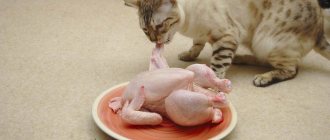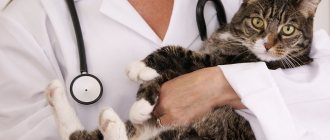It happens that a cat gets into trouble or gets sick - and then a period of treatment begins. Pets don't really like to be treated. They run away, act up, break out, scratch, and owners don’t really like moments when they need to give medicine to their pet.
It turns out that the key to success lies in a simple principle: “Minimum physical coercion and maximum care .
Today we will try to decipher this phrase and teach you how to give medications to your pet correctly.
What is important to consider when giving your pet medication?
Giving tablets, capsules, powders and mixtures seems much easier than giving a cat an injection. In reality, everything is not so simple. A cute pet will definitely remind you that it has teeth and claws.
Giving medications orally (orally through the mouth) must be done correctly:
- The best position for administering the drug is when the animal is sitting or in the sphinx position. This reduces the risk of medications entering the respiratory tract.
- Crushed pills and powders should not be poured dry into the animal’s mouth. High risk of suffocation.
- It’s a good idea to ask your veterinarian whether a certain drug can be given with food, dissolved in a liquid, or ground into powder.
- It is important to monitor the dosage. Especially in kittens, who are often prescribed a certain proportion of one tablet.
- It is strictly forbidden to give liquid medicine to cats lying on their back.
- When a cat is given a bitter or sour drug, foam may form in the mouth and excessive salivation. It's not critical. But next time it is better to choose a different method.
You cannot give your pet suspensions, solutions, dragees, capsules, syrups, mixtures on your own in the following cases:
- vomit;
- difficulty breathing;
- damaged neck muscles and skull bones;
- intestinal obstruction, constipation for many days, when there is a risk of complete blockage of the intestine or when a foreign body is suspected;
- painful lesions in the oral cavity.
How to remove worms from cats
There are a great many remedies for worms. Veterinary anthelmintic drugs can be in the form of tablets (prazicide, canikquantel, milbemax, drontal, etc.), pastes (dirofen), suspensions (prazicide, dirofen), drops on the withers (profender, leopard spot-on, prazicide complex).
If you find it difficult to give your pet a pill, you can give it a drink or treat it with special drops by squeezing the contents of a pipette between the shoulder blades, after first spreading the fur (in a place inaccessible to licking by the cat’s tongue).
How to give a pill to a kitten. Pay attention to what type of animal the drug is intended for, at what age it can be used, and for what weight the dose is calculated. Read the instructions especially carefully if your cat is pregnant or nursing kittens(!).
Modern products are designed for all types of worms (round and tape). They must be given strictly by weight(!), so the animal should be weighed and the dose strictly observed!
Emotional mood or how to tame a cat
A cat that feels threatened chooses different behavioral tactics:
- Scratch, bite, resist.
- Pretend to be dead or sick.
- Try to run and hide in a distant place, inaccessible to humans.
The owner at this moment needs to be calm and confident. All manipulations of administering medications cause stress in the animal. In addition, it senses the person’s mood. There is no need to shout or scold the ward. The pet must understand that its owner is in charge in the situation. Therefore, breeders recommend that you immediately take a dominant position, sitting on your knees above the cat and carry out manipulations.
The damage that worms cause to a cat's body
Worms living in the body of a pet harm it in different ways:
- worms feed on the blood, tissues and lymph of their host;
- helminths produce substances that lead to intoxication of the cat’s body;
- when the parasite dies, its decomposition products also poison your pet’s body;
- The suckers with which worms attach to organs can damage the mucous membranes of internal organs. This may lead to internal bleeding.
While there are few parasites, the animal may not notice their presence in its body.
But a large number of worms can significantly deplete the body. And a constant increase in the number of helminths will sooner or later lead to the death of the cat.
Ways to give pills
There are several options for giving your cat medications by mouth. You can feed, water, trick, force. You may have to try more than one method to achieve results.
Disguise
One of the easiest ways to give your cat a pill is to put it in tasty food. But at the same time hide it. Just a pill lying in a bowl will definitely not arouse the cat's interest.
However, often the cat eats the treat and spits out the tablet. Therefore, it is recommended to hide it in a small piece of meat (chicken, beef). A recess is made in the piece where the medicine is placed. It is advisable to feed before lunch. The pet swallows such “treats” without sensing a catch.
Store-bought camouflage products
Vet pharmacies and stores sell special products for masking medications:
- "Pill pockets." These are pieces of treats with a connector for a pill. They have different tastes that mask the smell of drugs. Made from meat, plant ingredients and flavored with natural flavors. The consistency of the pockets is like plasticine. Before feeding your cat a tablet, all you need to do is put it in the pocket and pinch the edge with your fingers. This method makes life easier for the owner and the cat.
- There are also pastes on sale that also mask medications. The paste is soft and stretchy, so it can be used to wrap a whole dragee of any size. And due to its pleasant taste, the cat will eat the tablet with pleasure.
- If you need to give a bitter drug, you can use gelatin capsules. Medicinal substances are placed inside the capsule. As a result, the unpleasant taste and smell disappear. Capsules are available in different sizes.
For sour cream lovers
In fact, it can be any other product with the consistency of sour cream that your pet likes.
- Grind the tablet into powder, mix with sour cream (pate).
- Place the cat on your lap. Stroke, calm.
- Apply the mixture to the animal's nose, but not too much.
- When the cat licks the sour cream, repeat the same steps.
The second option for giving a cat a pill is to dip the cat’s paw in a prepared mixture of medicine and something tasty. Animals are very clean and will immediately try to wash themselves.
Capsules with thick contents can be opened and the product can also be applied to the paw or nose.
Involuntary methods
If the pet understands that they want to force him to do something, he will try in every possible way to avoid it and hide. Therefore, when deciding to give medicine, you need to act confidently and quickly.
Method #1:
- Place the cat on a table or lap. It is preferable to place it on a table, since the smooth surface will prevent it from clinging to the claws.
- Cover your head with your hand. Use your thumb to press on the base of the jaw on one side, and your index finger on the other. If the cat does not open its mouth on its own, then with your other hand you need to lightly press on the lower teeth.
- Place the tablet in your mouth. Preferably at the root of the tongue.
- Cover your mouth and hold it so as not to open your jaw. But you should not cover your nose with your hand.
- Then stroke the throat from top to bottom, helping to swallow.
Rules for anthelmintic treatment
Regardless of which drug is used to treat a cat against helminths, several general rules must be followed. Firstly, the drug must be given on an empty stomach, preferably in the morning, before feeding. If your cat's food is freely available, you need to remove the bowl the night before. In addition, before anthelmintic treatment, you need to check whether the cat has fleas, which are carriers of worms. If fleas are found, you first need to rid your pet of them (spray, special shampoo, drops), and after a couple of days, worm the animal.
If annual vaccination is scheduled, worms should be removed two weeks before vaccination. In the preventive mode, if worms are not found in the feces and there are no specific signs of infection, the treatment is carried out once, but if the worms are present or came out after the pill, the treatment is repeated after ten days, it is better to use another drug for the secondary procedure.
Cats need to be dewormed every three to four months.
After the pet has received anthelmintic, it is necessary to ensure that the animal goes to the toilet “in a big way” within eight to twelve hours after the procedure. If this does not happen, you need to give the cat a laxative. Its role can be vaseline oil (half a teaspoon), or human syrup “Lactusan” or “Duphalac” (5-7 milliliters).
What should I do if my cat feels unwell after treatment?
After an animal has received a deworming tablet, two conditions may occur:
- Drug poisoning due to incorrectly selected dosage or intolerance to the active substances.
- Intoxication of the body due to decomposition products of dead parasites.
In this situation, vomiting, severe diarrhea, an increase in the pet’s body temperature are possible, the cat becomes apathetic, refuses to eat, tries to stay in a secluded place, and does not respond to calls and affection.
If the cat feels unwell after treatment, you need to take it to the clinic
The owner’s independent actions can only worsen the animal’s condition, so the cat must be taken to a veterinary hospital immediately. The veterinarian should be informed which drug and in what dosage the animal received; it is better to have a package of the drug with you.
Most likely, the animal will be prescribed IVs to flush out products that poison the body from the body; intestinal and stomach lavage may be necessary. If the number of parasites is so large that it has clogged your pet's rectum or colon, surgery may be indicated.
Worm infestations are especially dangerous for the fragile organism of kittens
To prevent such undesirable side effects from anthelmintic treatment from occurring, you must adhere to the following rules:
- Be sure to weigh your cat before treatment.
- Clearly calculate the dosage of the drug, not exceeding it under any circumstances.
- Do not give an animal an anti-worm tablet against a background of general ill health.
- During the day after treatment, closely monitor the pet’s condition.
- Treat regularly to prevent the accumulation of parasites. The date of each treatment must be written down in a special notebook, noting the name of the medicine and dosage.
When should you not give deworming pills?
It is necessary to postpone anthelmintic treatment if the cat is sick with something (until full recovery), after vaccination for a month, as well as for an injured, exhausted or weak animal. Also, contraindications for helminthization include the second half of pregnancy, the age of the kitten up to three weeks, diseases of the liver, kidneys, and genitourinary system.
It is prohibited to deworm cats in late stages of pregnancy.
Can I give the tablet with food?
Tablets that can be crushed or powdered medications can be tried sprinkled into food or mixed into wet food. Particles of the product will stick to the food and the animal will no longer be able to separate them. However, cats have a well-developed sense of smell and it is extremely difficult to deceive them. Therefore, the more correct way is to dilute the powder products with water and drink them from a syringe.
In addition, the disadvantage of this method is that the animal may end up missing the food or not eat it completely. In this case, it will be unknown how much of the drug entered the stomach.
Some drugs, for example, a number of antibiotics, are prohibited from mixing with food. They are given on an empty stomach. Or vice versa, you can’t help but mix. Therefore, it is imperative to follow the instructions and recommendations of the veterinarian.
Pills with a glycerin coating cannot be broken; in this case, you need to choose another way to give the pill to your cat.
Special device - peeler
Veterinarians have come up with an unusual but convenient device for delivering tablets to animals. It is called a piller, in the Russian version - a tablet dispenser. The piller can be purchased at a veterinary pharmacy and will come with detailed instructions for use.
The piller looks like a syringe, at the end of which instead of a needle there is a holder for tablets and capsules. It can be used to place medicine precisely down the animal's throat without the risk of it choking. In addition, the cat will definitely swallow the drug and not spit it out.
Devices for giving medicine
When a cat is given, for example, a deworming tablet, problems rarely arise. But when you need to undergo a course of treatment, the situation becomes more complicated. There is a special device called a tablet dispenser, bolus dispenser or introducer.
The device is a plastic syringe with soft nozzles: for suspensions and tablets.
The instructions are simple:
- Attach the tip to the tip of the syringe.
- Fill the syringe with water.
- Insert the tablet into the nozzle. If there are several tablets, secure them one after another.
- Tilt the cat's head slightly upward. Open your mouth slightly. You need to act quickly.
- Insert the introducer so that the nozzle is at the level of the root of the tongue and squeeze out the liquid.
- The tablets quickly slide down the esophagus.
Read the instructions or ask your veterinarian
Before proceeding with the main part of the procedure, you should carefully read the instructions for the drug or ask your veterinarian the following questions:
- Is it possible to mix tablets with water?
- Is it permissible to grind the product into powder;
- Will it be possible to dissolve the tablet in water?
- Is it possible to add the drug to fatty foods, for example, meat, sour cream or milk;
- If the product is in liquid form, does it lose its properties if it is diluted a little with water?
How to make sure your cat has swallowed a pill
When the tablet is in the mouth, you still need to make sure that it goes into the stomach. Cats can “hide” it behind their cheek and spit it out after some time. Especially if the pill is not bitter, they will tolerate it.
You can tell that the medicine has been swallowed by your behavior. The pet begins to lick its lips. At this moment it is important to encourage him, stroke him, caress him.
If you suspect that the pill has been spat out, but there is no evidence, it is better not to give the medicine again to avoid an overdose.
When to give your cat anthelmintics?
The main factor influencing how often to give your cat deworming tablets is the pet's lifestyle.
If your mustachioed pet often walks outside, then it is better to carry out preventive maintenance 4 times a year. Stay-at-home cats only need to be given a tablet once every six months.
The anthelmintic drug should be given on an empty stomach or 1.5-2 hours after eating. Since the animal may become slightly weaker after the procedure, treatment should begin no later than 2 weeks before the planned vaccination or mating.
How to Give a Cat Liquid Medicine
Liquid medications can also be mixed with food. But the best way to give suspensions, gels, mixtures is to give them a drink using a syringe without a needle. The advantage of this method is that you can accurately calculate the dosage and be sure that the cat will receive the medicine.
The tip of the syringe is placed in the corner of the mouth on the toothless part of the jaw. So that the pet has time to swallow the solution, it is administered slowly, in portions. It is advisable to pour the medicine from a syringe onto the upper palate or into the cheek pouch. In this situation, it is better to hold the cat by the scruff of the neck, without throwing back its head too much. When feeding a kitten, it is held vertically.
A suspension, be it an antibiotic or an antiparasitic drug, always precipitates. Therefore, be sure to shake it well before giving the product.
When to use a syringe
A cat will swallow liquid medicine faster than a tablet or powder. But more often the animal does not like the taste. Then you will need a syringe. If the cat is calm, then instead of a syringe, a large pipette will be enough. But it was not possible to gradually pour the medicine from the pipette.
The cat should be held on your lap, but it should not lie down - just sit. There is no need to open your mouth: just stick the syringe behind your cheek. You need to raise your head slightly, but not throw it back.
How to give medicine from a syringe
The medicine is administered slowly so that the cat has time to swallow it. During this procedure, you must ensure that the liquid does not enter the windpipe: to do this, at the moment of inhalation, you must stop the infusion of the solution. But if the cat still swallows the liquid incorrectly and coughs, the procedure must be stopped: calm the animal, let it cough, and only then continue.
If the veterinarian allows it, then it is better to dilute the medicine with water or milk to discourage the unpleasant taste.
Since holding a pet and administering medicine at the same time is difficult, it is better if someone assists - holding the cat on their lap.
Precautionary measures
To avoid injury during treatment, the owner must follow the following safety rules:
- It is advisable for two people to host the event.
- Secure the cat with a blanket, towel, or diaper.
- Prepare medications in advance and in another room. Otherwise, the cat will immediately feel that it is for him and will hide.
- Try to reduce the time of the procedure to a minimum. The longer an animal experiences fear, the more aggressive it becomes.
Cats are capricious and are unlikely to agree to take medication voluntarily. Therefore, it is recommended to accustom them to the procedure from childhood, accompanied by encouragement and affection.
Method 1: Add to food
Many owners try to “trick” the cat by slipping it a tablet of food. If the drug is in its entirety, then most likely the animal will spit it out or leave it in a bowl, and safely eat the rest. The solution may be to grind the medicine to a powder state. In addition, two conditions must be met:
- wait until the cat is very hungry (this will slightly dull its taste buds, at least for the first few seconds);
- mix the powder with a small amount of food (after satisfying your hunger with the first portions, your mustachioed friend can leave some of the medicine in the bowl).
Attention: not all medications can be taken with food!
Taking a tablet in food is the most cunning way, but it is not suitable for all medications.
Method 5. Use a tablet dispenser
A special device - a tablet dispenser, or piller - will help make the task of swallowing medicine easier. In appearance and principle of operation, it resembles a syringe, but instead of a needle it has a long soft tube. To give a pill to a cat, simply insert the medicine into the tip of the tube, open the animal's mouth, and then press the plunger. Under the influence of air, the drug will reach its destination.
Note: such a device is sold at a veterinary pharmacy or pet store. However, you can make it yourself by cutting off the bottom of a plastic syringe of the required diameter.
We use a tablet dispenser
A very obedient cat who loves pills











